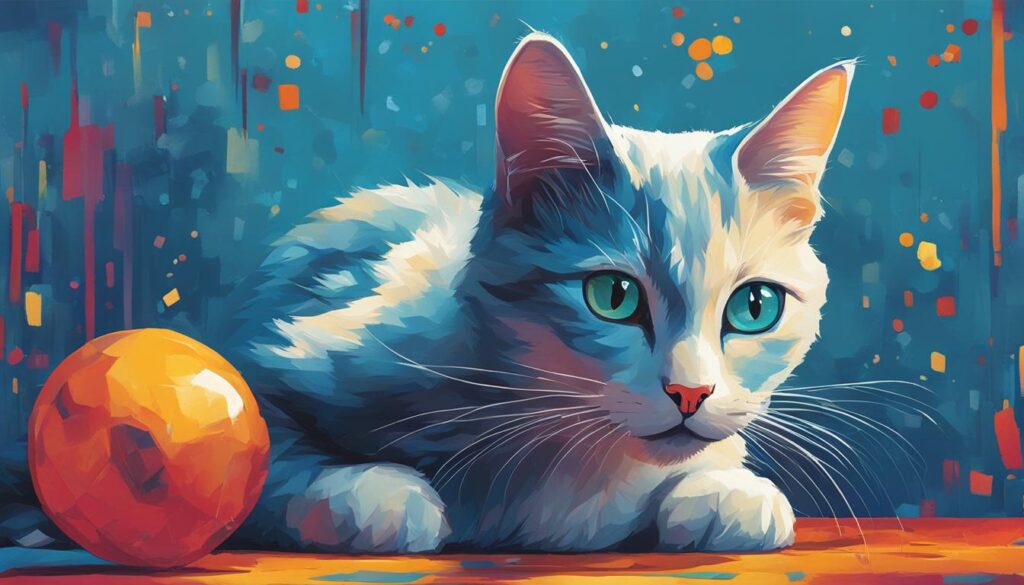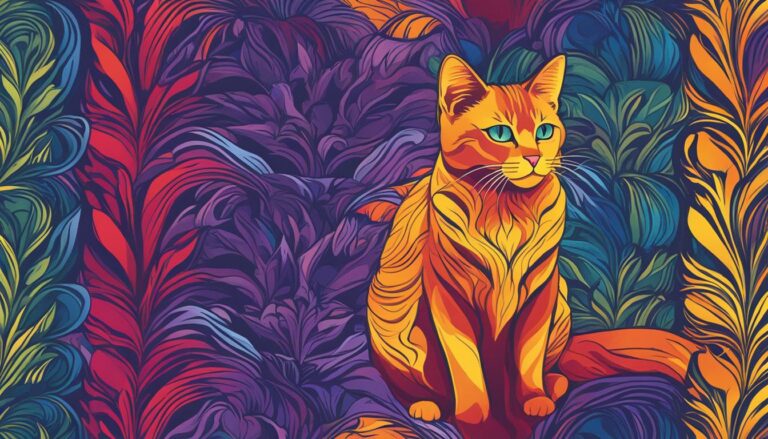Cats have unique colour perception compared to humans. Their vision is different due to the number of colour receptors in their eyes, and the way their brain processes colour information. While humans have three colour receptors (cones), cats only have two. This means that cats are better able to distinguish between shades of blue and green, but struggle with colours in the red spectrum. Understanding how cats see colours is essential to understanding their colour preferences and creating a stimulating environment for them.
Wichtigste Erkenntnisse:
- Cats have two colour receptors, making them more sensitive to blues and greens.
- Cats have limited ability to see colours in the red spectrum.
- Understanding a cat’s colour preferences can help create a comfortable and stimulating environment for them.
- Cats may have specific colour preferences influenced by breed tendencies, personal experiences, and environmental factors.
- Calming shades of blue and green are ideal for bedding and toys, while bright colours like red or orange may cause anxiety in some cats.
How Do Cats See Colors?
Cats have a unique way of perceiving colors compared to humans. Their vision is influenced by the number of color receptors in their eyes and the way their brain processes color information. While humans have three color receptors or cones, cats only have two. This means that cats have a limited ability to see colors in the red spectrum but are better at distinguishing shades of blue and green.
The two color receptors in a cat’s eyes are sensitive to different ranges of colors. One receptor is sensitive to blues and greens, while the other is sensitive to yellows and oranges. This allows cats to see a variety of colors, but they may struggle with distinguishing between colors in the red spectrum. Additionally, the way cats process color information in their brains is different from humans. Cats rely on a region called the ‘dorsal lateral geniculate nucleus’ for color processing.
Despite their differences in color vision, cats can still perceive a range of colors and may have preferences for certain colors. It is important to note that individual cats may have varying color preferences. Some cats may be more attracted to colors on the blue and green spectrum, while others may have preferences for different hues. Observing your cat’s behavior and reactions to different colors can help you determine their preferences and create a stimulating environment for them.
| Farbe | Perception in Cats |
|---|---|
| Blue | Can be calming and soothing for cats. Often associated with peace and relaxation. |
| Green | Can have a refreshing and natural vibe. Also a popular color among cats. |
| Red/Orange | May be too overwhelming for cats’ sensitive eyes and may not be as attractive to them. |
Understanding how cats see colors is essential for creating an environment that appeals to their visual senses. By considering their unique color perception and individual preferences, you can select colors that enhance their well-being and ensure they feel comfortable in their surroundings.
Exploring Feline Color Preferences
Cats, with their unique feline visual abilities, perceive colors differently from humans. While some studies suggest that cats may not have a favorite color, there are certain colors that tend to be more popular among our feline friends. Understanding these color preferences can help create a stimulating and comfortable environment for your furry companion.
Blue is often associated with peace and relaxation, making it a popular choice for feline accessories such as bedding and toys. Its calming effect can help create a serene atmosphere for your cat. Another color that cats are attracted to is green. With its natural and refreshing vibe, green can evoke a sense of the outdoors, which many cats find appealing.
“Blue and green are the colors of nature, and cats are instinctively drawn to them.” – Veterinarian Dr. Emily Turner
On the other hand, cats may not be as drawn to colors like red and orange. These warm-toned colors can be overwhelming for their sensitive eyes. Cats have a limited ability to see colors in the red spectrum, so these colors may appear less vibrant or even dull to them. It is best to avoid these colors when choosing accessories or creating a cat-friendly environment.
Table: Popular Colors among Cats
| Farbe | Associations |
|---|---|
| Blue | Peace, relaxation |
| Green | Nature, refreshment |
| Red | Stimulation, intensity |
| Orange | Energetic, warmth |
Each cat is unique, and their color preferences may vary. It’s important to observe your cat’s behavior and reactions to different colors to determine their individual preferences. Experiment with different colors and pay attention to how your cat interacts with objects of different hues.
By considering feline color preferences and creating a visually appealing environment, you can enhance your cat’s quality of life and nurture a stronger bond with your furry friend.
Factors Influencing Cat Color Preferences
When it comes to cat color preferences, several factors can play a role in shaping their choices. These factors can range from breed tendencies to personal experiences and environmental influences. Understanding these factors can help you create a more tailored and enjoyable environment for your feline friend.
Breed tendencies are one factor that can influence a cat’s color preferences. Different cat breeds may have specific inclinations towards certain colors. For example, the Siamese breed is known for its preference for light-colored coats, while the Russian Blue breed tends to favor shades of gray. By considering your cat’s breed, you can get an idea of what colors they may be naturally drawn to.
Personal experiences also contribute to a cat’s color preferences. Cats may associate specific colors with positive or negative experiences. For instance, if a cat had a positive experience with a red toy, they might develop a preference for that color. On the other hand, if they had a negative encounter with an orange object, they may develop an aversion to that color. Paying attention to your cat’s reactions and behavior towards different colors can provide valuable insights into their preferences.
Environmental factors, such as the color of their surroundings, can also influence a cat’s color preferences. Cats are sensitive to their environment and may be more inclined towards colors that blend harmoniously with their surroundings. If your cat’s environment predominantly features certain colors, they may develop a preference for those colors. Consider incorporating colors that complement your cat’s surroundings to create a visually pleasing and comfortable space.
Factors Influencing Cat Color Preferences:
| Faktoren | Beschreibung |
|---|---|
| Breed Tendencies | Different cat breeds may have specific inclinations towards certain colors. |
| Personal Experiences | Cats may associate specific colors with positive or negative experiences, shaping their preferences accordingly. |
| Environmental Influences | The color of their surroundings can impact a cat’s color preferences, with cats naturally being drawn to colors that blend harmoniously with their environment. |
By considering these factors, you can gain valuable insights into your cat’s color preferences and create an environment that aligns with their unique tastes. Whether it’s choosing toys, bedding, or decor, selecting colors that resonate with your cat can enhance their overall well-being and happiness.
Note: Remember that individual cat preferences may vary, so it’s essential to observe your feline companion’s reactions and behaviors to ascertain their specific likes and dislikes.

Emphasize:
- Shades of blue
- Shades of green
Avoid:
- Bright red
- Bright orange
Schlussfolgerung
Understanding your cat’s color preferences is essential for creating a comfortable and stimulating environment for them. Although cats see colors differently from humans, they have their unique set of preferences that can be observed and catered to. By considering factors such as breed tendencies, personal experiences, and environmental influences, you can choose the best colors for your cat’s toys, accessories, and overall surroundings.
While cats may not have specific favorite colors, they are particularly responsive to colors on the blue and green spectrum. These colors can have a calming and soothing effect on cats, making them ideal for bedding and toys. On the other hand, it’s best to avoid brighter colors like red or orange, as they may be overstimulating and cause anxiety in some cats. Opting for calming shades of blue or green can help create a serene and enjoyable environment for your feline companion.
By understanding and catering to your cat’s color preferences, you can enhance their quality of life and strengthen the bond between you. Keep an eye on their behavior and reactions to different colors, and adjust their surroundings accordingly. Your efforts in creating a color-conscious environment will not only benefit your cat’s well-being but also contribute to a harmonious and happy life together.




